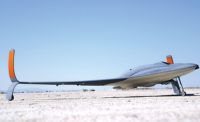Overheating is one of the biggest challenges facing engineers developing new types of battery technology. Too much thermal activity can reduce performance, cause malfunctions and increase the risk of fires and other serious problems in electric vehicles.
To address the issue, engineers at Drexel University are focusing on cooling systems. They’ve created a blood vessel-like network in the packaging of a new generation of carbon-fiber composite based batteries. It addresses performance-enhancing factors, like battery capacity and conductivity.
“One of the primary hindering factors in the development of EVs is that the specific energy of batteries is low, which makes vehicles heavy, especially for a long-range design,” says Ahmad Najafi, Ph.D., an assistant professor of mechanical engineer at Drexel University.
According to Najafi, growing demand for EVs has been plagued by a number of high-profile recalls that have called the durability and safety of batteries into question. As a result, more automakers and suppliers are looking at using solid batteries—a thin, carbon fiber-based version of the larger lithium-ion batteries widely used in electric vehicles—because they can be incorporated into the physical structure of the vehicle chassis as a way to cut weight.
Trimming the weight of a car by just 10 percent can boost its mileage efficiency between charges by as much as 6 percent to 8 percent. Najafi believes that replacing portions of a car frame with carbon-fiber composite material that functions both as a structural component and as a battery could reduce overall weight as well as improve energy storage capacity.
However, for these structural batteries to succeed, engineers must first address a challenge that arises from the use of a solid polymer rather than a liquid electrolyte.
“Heat generation will be substantially higher in structural batteries [compared to] standard lithium-ion batteries,” says Najafi. That’s because the conductivity of the polymer electrolyte is much smaller than that of liquid electrolytes.
Electrons face more of a bottleneck as they move through the polymer. They’re forced to move slower and, as a result, generate more heat as the battery discharges its energy.
“While structural battery composites are a promising technology for reducing weight in electric vehicles, their design could certainly benefit from the addition of a thermal-management system,” explains Najafi. “Not only could this improve the range of an EV, but it would also greatly reduce the chances of a thermal runaway reaction.”
Najafi and his colleagues have been developing special composite materials for heat management. They tapped into nature’s own cooling method—the vascular system—to dissipate heat. Modifying a design tool they invented to plot the optimal microvascular network, the engineers were able to design cooling composites that would work as part of the structural battery packaging currently being tested by automakers such as Tesla, Volkswagen and Volvo.
The design system can calculate the best pattern, size and number of microvascular channels to quickly dissipate heat from batteries. It also optimizes the flow efficiency of coolant moving through the channels.
“These composites function something like a radiator in an internal combustion engine vehicle,” Najafi points out. “The coolant draws in the heat and pulls it away from the battery composite as it moves through the network of microchannels.”
Sandwiching structural batteries between layers of cooling microvascular composites can stabilize their temperature during use, and extend the time and power range in which they can function.
Najafi’s structural battery optimization process includes several design parameters, such as thickness and fiber directions in each layer of carbon fiber. Other factors that affect performance include the volume fraction of fibers in the active materials, and the number of microvascular composite panels required for thermal regulation.
To test each combination, Drexel engineers measured the stiffness of each structural battery-cooling composite laminate to ensure they met safety standards. Then, they simulated the energy demand of a vehicle at various speeds over a duration of several minutes, while recording the temperature of the battery and the predicted range of the vehicle.
Computer models of one optimized system showed that it could improve the driving range of a Tesla Model S by as much as 23 percent. However, Najafi believes the real value of the R&D effort is its ability to glean the best combination of battery size and weight for any electric vehicle.
“While we know that every bit of weight savings can help improve the performance of an EV, thermal management can be just as important—perhaps more—when it comes to making people feel comfortable driving them,” says Najafi. “Our system strives to integrate improvements in both of these areas, which could play an important role in the progress of electric vehicles.”









